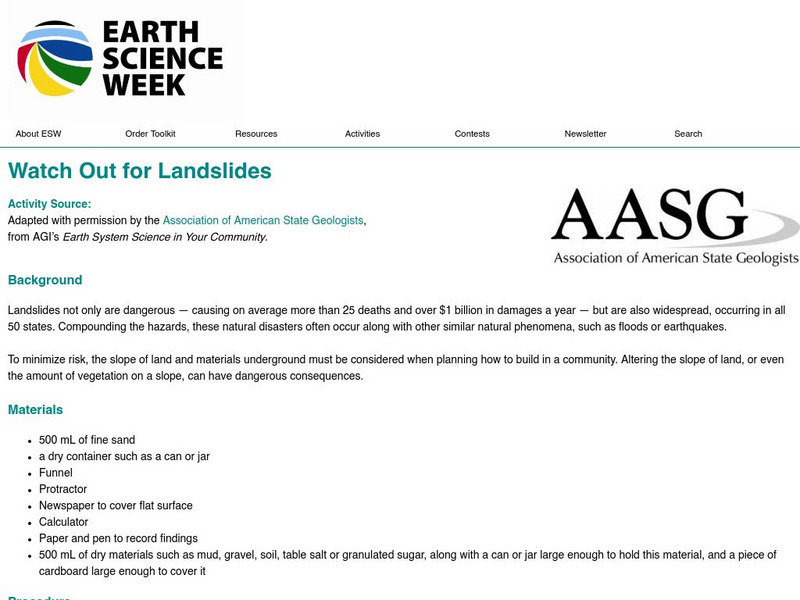National Nanotechnology Infrastructure Network
Big vs. Little - Macro to Micro Lesson 5
It is a long way from nano to macro. Learners examined the scale of measurement from macro to nano in the first four lessons of the five-part series. With the final installment, they review what they learned by classifying objects in one...
National Nanotechnology Infrastructure Network
Big vs. Little - Macro to Micro Lesson 1
Small and large are relative terms; what's the best way to quantify them? Young scientists take on that challenge as they complete an interactive activity to explore size. They build structures during their exploration and begin using...
Kenan Fellows
The Little Stuff Can Make a Big Difference
Great things come in small packages! What better way to illustrate this point than a week-long look at nanotechnology? Earth science scholars explore water quality issues through lab activities, then research new innovations in nanotech...
National Science Teacher Association
Middle School Sampler: Science
Focus on inquiry-based learning in your science class with a series of activities designed for middle schoolers. A helpful packet samples four different texts, which include activities about predator-prey relationships, Earth's axis and...
University of Wisconsin
Infiltration Test: Exploring the Flow of Water Through Soils
Soil scientists gain experience with an infiltrometer can to determine the infiltration rates at different locations on campus. If you are using the entire unit, the class has already analyzed water flow and soil types, so they should...
University of Wisconsin
Identifying Your Soil for Rain Gardens
Teach your class the descriptive characteristics of soil. Provide information about particle size and a flow chart for assessing texture. Soil scientists then analyze samples and hypothesize which would be the best type for a rain...
Curated OER
Particles: Size Makes All the Difference
High schoolers plot particle sizes of common airborne materials on a log scale. They read an article on particle size and its relationship to the ability to pass through the lungs, into the bloodstream, and eventually into the cells of...
Curated OER
Soil Water Worksheet #1
Drawings of four groups of soil particles of varying sizes are displayed across the page for soil scientists to examine. As they complete the worksheet, place a set of similar soils at each table for hands-on experience. In this way,...
Curated OER
Chapter 3 ~ Physical Properties of Soil
Though information-packed, this presentation on soil is drab if it stands alone. As you journey through slides about soil texture, make sure to pass around samples of each type. Perform demonstrations as you lecture on soil density and...
Curated OER
Factors Affecting Weathering
In this weathering worksheet, students use Alka-Seltzer tablets to simulate the effects of particle size on weathering and they study the effects of temperature on weathering. They answer questions to conclude the activity.
Curated OER
Analyze Your Sand Samples
In this sand sample worksheet, students analyze a sample of sand and indicate the site the sand was from, the size of major and minor particles, the presence of shells and magnetic particles, the colors present and the shapes of the sand.
Curated OER
Water Velocity
In this water instructional activity, students use a graph comparing particle diameter with stream velocity to complete 6 fill in the blank questions.
Curated OER
Bellwork for Week 11
In this bellwork instructional activity, students answer questions about chemical and mechanical weathering, particle size, and the soil profile at the start of class.
Curated OER
Water Flow Through Local Soils
Learners examine the relationship between particle size and rate of water flow through soil. They collect soil samples, make predictions, conduct a water flow experiment, analyze the data, and answer conclusion questions.
Science Buddies
Science Buddies: Big Pieces or Small Pieces: Which React Faster?
Use an Alka-Seltzer to find out how size of a particle affects the speed of a chemical reaction. The Science Buddies project ideas are set up consistently beginning with an abstract, objective, and introduction, followed by a section on...
Science Buddies
Science Buddies: Can You Change the Rate of a Chemical Reaction?
The ingredients in Alka-Seltzer tablets undergo a chemical reaction that produces carbon dioxide gas as soon as the tablets hit water. Do you think you can cause the tablets to produce gas faster by breaking them into smaller pieces...
Other
Clemson University: Soil Acidity and Liming
Covers the composition and uses of liming materials in agriculture, as well as the lime codes of several states. Good definitions of terms: lime, calcitic limestone, calcite, dolomite, dolomitic limestone, aragonite, hi-cal lime, and more.
American Geosciences Institute
American Geosciences Institute: Earth Science Week: The Slope of Land in Your Community
Students investigate how particle size and shape relate to the maximum slope angle the particles will maintain during a landslide.
American Geosciences Institute
American Geosciences Institute: Earth Science Week: Watch Out for Landslides
Students investigate how particle size and shape relate to the maximum slope angle the particles will maintain during a landslide.
Concord Consortium
Concord Consortium: Molecular Workbench: Size Segregation of Vibrating Particles
View this simulation to observe how larger particles can be separated from smaller particles through vibration.





















